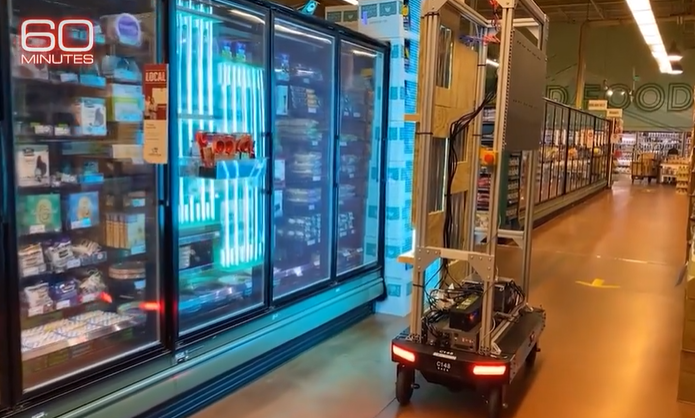Amazon’s New COVID-Killing Robot is Covered in UV Lights
How do you disinfect thousands of large facilities without putting human workers at risk? Amazon has come up with a potential solution. The retail behemoth is working on a robot that can roll through its grocery stores and distribution centers, disinfecting surfaces all around it with banks of ultraviolet lights. The company unveiled its creation on “60 Minutes” as part of an effort to push back against criticism that it’s not doing enough to protect its employees.
The prototype consists of ultraviolet tube lights attached to a vertical rack, all supported by a self-driving platform on wheels. It’s tall enough to disinfect almost all touchable surfaces, all the way to the top of those towering Whole Foods store aisles. In the video, you can see it rolling slowly down the freezer aisle, beaming its microbe-killing lights onto the doors of the cases.
Ultraviolet light at wavelengths between 200 and 280 nanometers is capable of cutting into DNA and RNA, destroying its genetic material. This method of disinfection is already in use by hospitals, airplanes, factories, and offices around the world.
“We have great ideas coming from all areas of the company,” Amazon spokeswoman Kristen Kish told Business Insider. “Our Robotics group in particular has become an R&D lab for COVID innovation — first using machine learning to detect social distancing opportunities in our building, to now beginning to design and test disinfecting with mobile ultraviolet sanitation.”
“While these mobile units are not currently being used in any Amazon or Whole Foods Market locations, we’re excited about the possibilities and will continue to innovate to ensure that we are supporting our employees, customers, and communities.”
As the 60 Minutes report on Amazon’s response to the pandemic notes, the company has been a target of criticism from workers and their advocates for refusing to close down its distribution centers for cleaning and disinfection when employees test positive. Amazon’s notoriously “unsafe, grueling” conditions at these facilities were already under scrutiny before the virus hit. Workers face long shifts, few breaks, high productivity quotas and injury rates, and typically work in close quarters with each other.
Among the steps the company has actually taken in response to the coronavirus are mandatory temperature checks, masks at the door, rolling washing stations, and a vast network of surveillance cameras keeping tabs on worker locations and interactions.
The disinfecting robot provides a tool for active, ongoing disinfection, which is important but still doesn’t address the other concerns. Workers in places like California say Amazon’s policies are forcing sick employees to work. On May 1st, the company ended a policy instituted at the onset of the crisis allowing unlimited unpaid time off for illness, childcare duties, or concerns about safety at work.
Amazon has refused to release official numbers of cases among its workers. Meanwhile, the company’s sales have surged, and its founder and CEO Jeff Bezos is set to become the world’s first trillionaire by 2026.
Amazon’s creation isn’t the only COVID-killing robot in town. “Violet” is a new version of “Stevie,” a robot created by Trinity College Dublin’s Robotics and Innovation Lab to assist aging individuals in care homes. The 4-foot 7-inch tall “social robot” is designed to tell stories, lead sing-alongs and interact with residents to alleviate loneliness, featuring sensors that help it navigate independently and stop when it detects a person nearby. Now, it will be equipped with UV-C lights to navigate hospitals and assist health care workers and patients.





